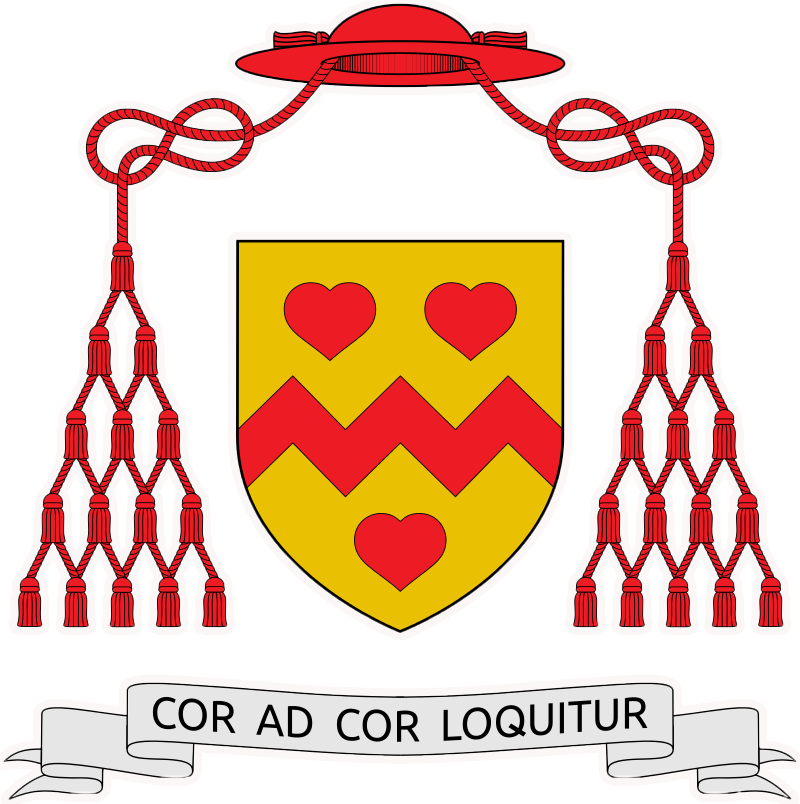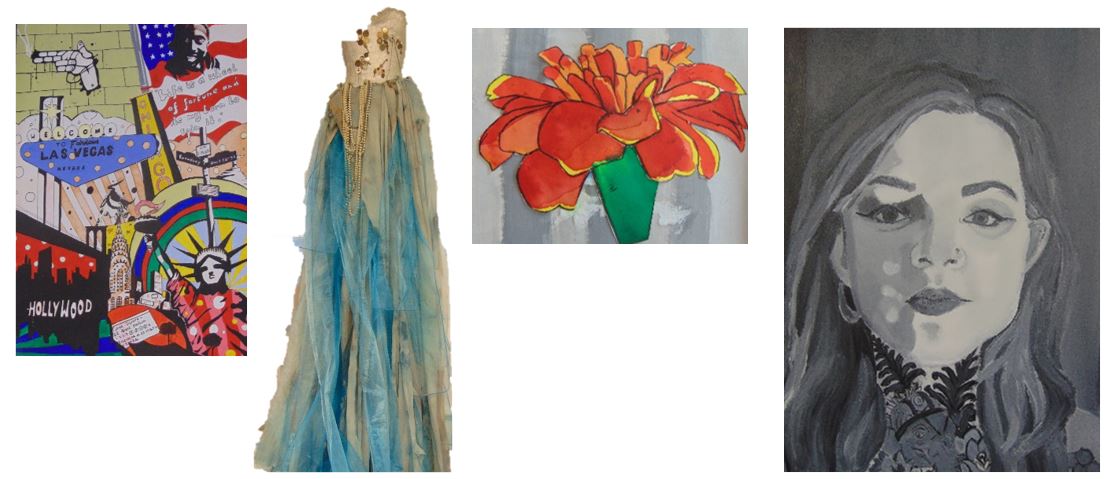Art
Welcome to our Art Section
 Within these pages you will find lots of information about the subject and how the department operates.
Within these pages you will find lots of information about the subject and how the department operates.
The Art Department has a warm, vibrant and inviting environment. We encourage a sense of awe and wonder in our students while reflecting the British Values of tolerance and respect, democracy, rule of law and individual liberty. Cultural capital is threaded through our learning journey from Year 7 to Year 13. Our department motto, ‘to create is to be truly close to God’ reflects that Christ is at the centre of all we do.
Full Time Art Teacher - Miss L C Cook
Part Time Art Teacher - Mrs R Dow-Richardson

Key Stage 3
Year 7
The Art department build on work covered in the KS1 and KS2 programmes of study. Pupils should come to us having had experience of:
- Producing creative work, exploring ideas and recording their experiences
- Drawing, painting, sculpture and other art, craft and design techniques
- Evaluating and analysing creative works using the language of art, craft and design
- Knowing about great artists, craft makers and designers, and understanding the historical and cultural development of their art form
 We start Year 7 with observational drawing. We look at shells because they come in lots of different shapes, sizes and textures which makes them effective to scaffold for SEN. We really want pupils to understand how to analyse objects and to record what they can see, not what they think is there! We have real shells to draw from which gives pupils the opportunity to use all their senses to record the experience. We use measuring negative space and grids to help with scale and proportion, basic shapes are used too and these techniques link with maths. We want pupils to have ‘can do’ attitudes towards drawing so that they gain confidence. We look at how light changes the tone and depth of an object and learn to gradate shading to change shapes into forms.
We start Year 7 with observational drawing. We look at shells because they come in lots of different shapes, sizes and textures which makes them effective to scaffold for SEN. We really want pupils to understand how to analyse objects and to record what they can see, not what they think is there! We have real shells to draw from which gives pupils the opportunity to use all their senses to record the experience. We use measuring negative space and grids to help with scale and proportion, basic shapes are used too and these techniques link with maths. We want pupils to have ‘can do’ attitudes towards drawing so that they gain confidence. We look at how light changes the tone and depth of an object and learn to gradate shading to change shapes into forms.
Continuing the theme of shells, we move onto colour theory and colour mixing. Pupils explore how to mix secondary and tertiary colours and learn how to apply paint with control. We look at the work of the contemporary artist Amiria Gale for inspiration to create individual creative work. Analysing artists work is threaded through all the units of work throughout all key stages. We rotate between Computer aided Design and colour work in this unit to give pupils the opportunity to explore further media. They use basic shapes yo create shells.
We then move onto Pop Art cakes and ice cream towers inspired by the great Pop Artist Wayne Thiebaud. These are more challenging to draw especially as the scale is much larger. We use mixed media, paper batik and oil pastels to expand student’s skill and technique range and allow them to explore in a much freer way.
Year 8

Building on the work we do in year 7, students will develop their skills further. Our first unit is ‘Funky Feet’ and we start with observational drawing of shoes. Shoes are much more complex objects to draw than shells and there are very many to choose from, meaning work can be scaffolded to suit each student’s ability; we really want to challenge! Our inspiration comes from the great shoe designer Manolo Blahnik and the street artist Banksy. We go back to colour work using ink rather than paint, so students experience a range of ways to apply colour. We rotate between CAD and colour work; students use basic shapes to create a shoe image. We develop our shoe drawings into 3D paper engineered shoes complete with shoebox.
work can be scaffolded to suit each student’s ability; we really want to challenge! Our inspiration comes from the great shoe designer Manolo Blahnik and the street artist Banksy. We go back to colour work using ink rather than paint, so students experience a range of ways to apply colour. We rotate between CAD and colour work; students use basic shapes to create a shoe image. We develop our shoe drawings into 3D paper engineered shoes complete with shoebox.
Our next unit is ‘Japan’ where we explore the countries rich culture. We investigate blossom trees and flowers and Koi Carp as these are beautiful associations with Japan and even more challenging than shoes to record! We use paper batik to create individually creative pieces.
Year 9
 In the first unit we study portraits because they are very complex to draw. Faces have lots of lumps and bumps! They change dramatically with both expression and viewpoint and this raises the challenge further. The key knowledge and skills they learn from this unit is how the formal elements of drawing, (i.e., tone, line, planes, tone, relief).
In the first unit we study portraits because they are very complex to draw. Faces have lots of lumps and bumps! They change dramatically with both expression and viewpoint and this raises the challenge further. The key knowledge and skills they learn from this unit is how the formal elements of drawing, (i.e., tone, line, planes, tone, relief).Pupils will be analysing the work of the Cubists and more contemporary artists, Marion Bolognesi and Silvia Preserrio. From observational drawing, which includes understanding the proportions of the face, we develop images into ink work, painting and printmaking techniques. We build on the portrait theme to ‘Beneath our Skin’ where students study the structure of skulls which define our individual faces. We study Day of the Dead traditions and explore pattern and colour, sugar skulls and a variety of mixed media.
From here, we move to ‘Identity’ where our focus is based around the artist Frida Kahlo.

Key Stage 4
At GCSE level, we follow the AQA Fine Art Specification:
Fine art practice is defined as the need to explore an idea, convey an experience or respond to a theme or issue of personal significance. The course consists of two components as follow:
Areas of study
In Component 1 and Component 2 pupils are required to work in one or more area(s) of fine art, such as those listed below:
- Drawing
- Painting
- Sculpture
- Installation
- Lens-/light-based media
- Photography and the moving image
- Printmaking
- Mixed media
- Land art
They may explore overlapping areas and combinations of areas.
More details may be found from the AQA website.
https://www.aqa.org.uk/subjects/art-and-design/gcse/art-and-design-8201-8206/subject-content
https://www.aqa.org.uk/subjects/art-and-design/gcse/art-and-design-8201-8206/specification-at-a-glance
Year 10
In Year 10, pupils begin Component 1 of the GCSE course. All work completed goes towards the final exam grade (9-1).
The GCSE Fine Art Course encourages pupils to develop:
- Creative and imaginative powers and the practical skills for communicating and expressing ideas, feelings and meanings in art, craft and design.
- Investigative, analytical, experimental and interpretive capabilities, aesthetic understanding and critical skills.
- Understanding codes and conventions of art, craft and design and awareness of contexts in which they operate.
- Knowledge and understanding of art, craft and design in contemporary societies and in other times and cultures.
The skills and techniques developed in KS3 enable students to respond to the four assessment adjectives required for GCSE. We continue to make improvements by interleaving existing skills.
In unit one we study natural forms in the form of Trees and Leaves. We look at British Artists David Hockney and Andy Goldsworthy and the German artist, Gustav Klimt to inform our work and to make comparisons. Students take their own photographs of trees and leaves to draw and are encouraged to draw from life. We study this unit at this time of year because the colours of autumnal trees and leaves are beautifully diverse.
We record observations and develop these into paint, oil pastel and mixed media using creative colour schemes inspired by our artists
Unit 2 stays with the theme of natural forms but we move onto ‘Close Ups’.
Pupils are free to explore media and techniques and refine their work as it progresses.
Year 11
Year 11 continues to build on pupil’s personal investigations and understanding from their work in Year 10.
They respond to the four assessment objectives that make up the success criteria. These include drawing from observation, collecting and gathering appropriate visual information, researching and relating work to a chosen artists or culture and exploring a variety of different media.
They develop a personal response to their theme by drawing from their personal experiences and investigations.
We continue with the theme ‘close up’. Students can develop their ideas into subjective or objective genres. They choose their own starting point based on their interests, hobbies or passions, which prepares them for their exam paper.
Component 2 comprises an externally set task. Students choose from seven starting points and use the skills and techniques they have been building from year 7. They use year 10 and 11 sketchbooks to show them what they need to have in their sketch books to hit all four assessment objectives and to show the journey from their starting point to their final piece.
The exam is ten hours and pupils use this time to make their final piece.
Key Stage 5
Course Outline
We follow the AQA Fine Art specification which of two components of work.
In Component 1, pupils develop work based on an idea, issue, concept or theme leading to a finished outcome or a series of related finished outcomes. Practical elements should make connections with some aspect of contemporary or past practice of artist(s), designer(s), photographers or craftspeople and include written work of no less than 1000 and no more than 3000 words which supports the practical work.
In Component 2, pupils respond to a stimulus, provided by AQA, to produce work which provides evidence of their ability to work independently within specified time constraints, developing a personal and meaningful response which addresses all the assessment objectives and leads to a finished outcome or a series of outcomes.
This is a practical unit with written elements in which candidates are expected to develop a personal Investigation based on an idea, issue, concept or theme leading to a finished piece or pieces.
The practical elements are linked with some aspect of contemporary or past practice of artists, designers or craftspeople.
The exam papers will consist of a choice of eight questions to be used as starting points. Candidates are required to select one.
Preparatory work is submitted in any appropriate form with sources identified and acknowledged.
There is a 15-hour supervised period in which candidates must complete, unaided, their response to their chosen examination question.
The key knowledge students need is how to respond to four assessment objectives. In addition, they must produce a written piece relating to their theme.
In year 12, we build on skills and techniques from KS4 starting with the theme ‘Everyday Objects’. We analyse the work of Claes Oldenburg in much more depth than KS4 and come to a greater understanding that art of note always reflects society of the time.
From Pop Art we study Cubism still life inspired by Picasso and British Cubist, Ben Nicholson. We build on the techniques of texture and relief and research the origins of Cubism and how different perspectives are used on one plane.

From Pop Art we study Cubism still life inspired by Picasso and British Cubist, Ben Nicholson. We build on the techniques of texture and relief and research the origins of Cubism and how different perspectives are used on one plane.
In Year 13 we work from past exam papers. Pupils choose their starting point based on their skills/technique strengths. Pupils research artists in depth which feeds into their written component. They work independently evaluating and analysing as work progresses.Work in Year 12 supports the journey from their starting point to their final personal response.
Course requirements:
Grade C or above in Art and Design plus two other GCSE passes at grade C or above. A genuine interest in the subject is essential!












